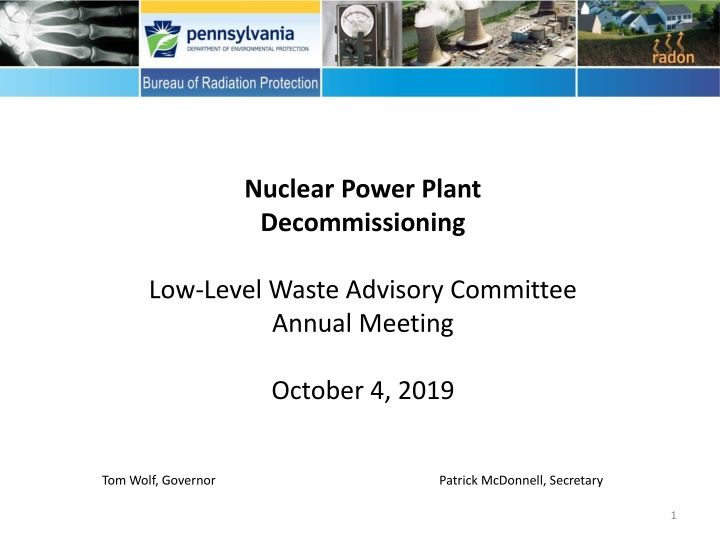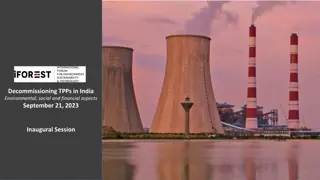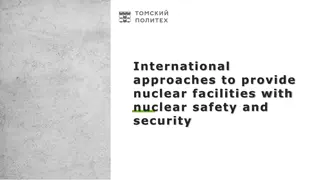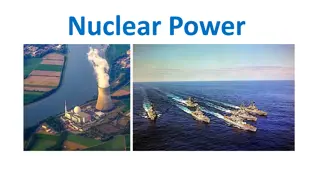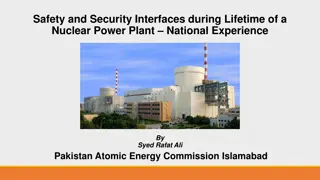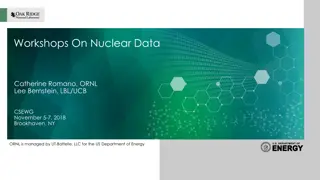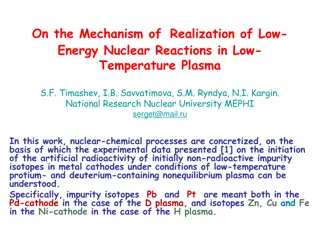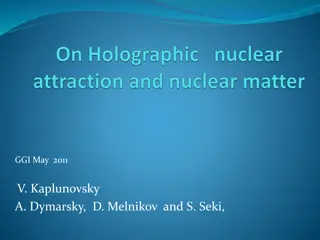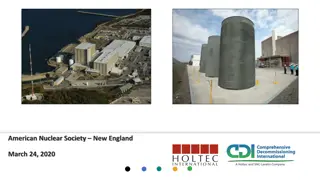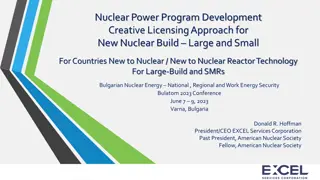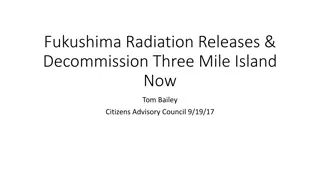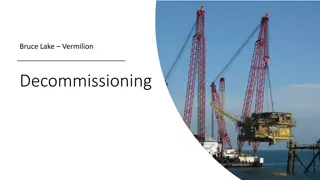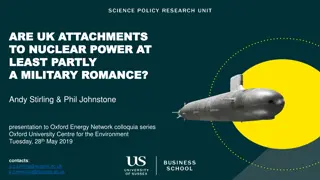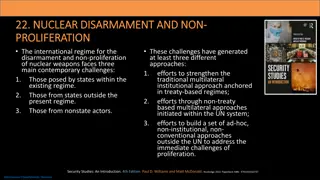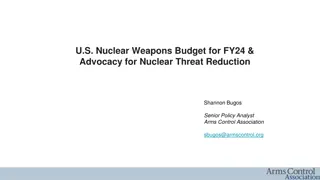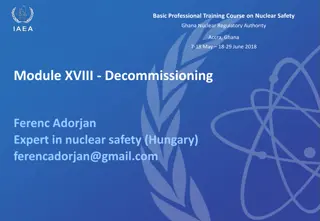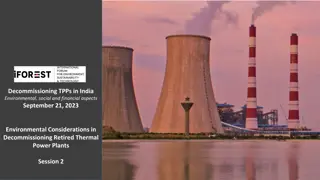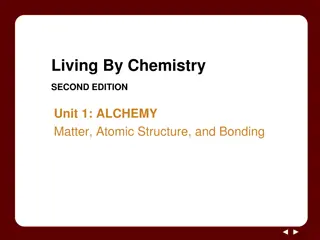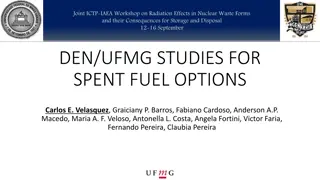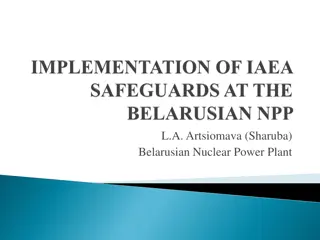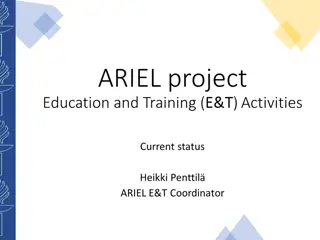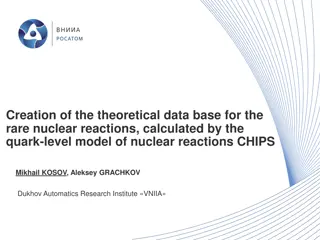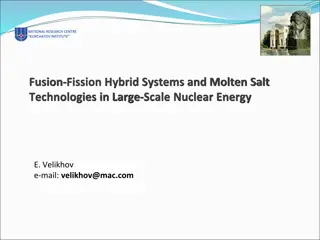Nuclear Power Plant Decommissioning Overview
Decommissioning of nuclear power plants involves the removal of facilities from service and reducing residual radioactivity to a safe level for license termination. Methods include immediate dismantling, deferred dismantling, and entombment. Licensees must establish funds for the decommissioning process, with oversight by the NRC. Phases include transitioning from operation to decommissioning and undertaking major decommissioning activities.
Download Presentation

Please find below an Image/Link to download the presentation.
The content on the website is provided AS IS for your information and personal use only. It may not be sold, licensed, or shared on other websites without obtaining consent from the author.If you encounter any issues during the download, it is possible that the publisher has removed the file from their server.
You are allowed to download the files provided on this website for personal or commercial use, subject to the condition that they are used lawfully. All files are the property of their respective owners.
The content on the website is provided AS IS for your information and personal use only. It may not be sold, licensed, or shared on other websites without obtaining consent from the author.
E N D
Presentation Transcript
Nuclear Power Plant Decommissioning Low-Level Waste Advisory Committee Annual Meeting October 4, 2019 Tom Wolf, Governor Patrick McDonnell, Secretary 1
What is Decommissioning? Removal of a facility from service and reduction of residual radioactivity to a level that permits termination of the NRC license NRC requires the licensees to decommission the nuclear plant after it ceases power operations NRC regulates and provides oversight of the decommissioning process 2
Decommissioning Methods DECON (immediate dismantling) - The equipment, structures and portions of the facility containing radioactive contaminants are removed and decontaminated to a level that permits release of property and termination of the NRC license. SAFSTOR (deferred dismantling) The facility is maintained and monitored in a condition that allows the radioactivity to decay; afterwards the plant is dismantled and property decontaminated. ENTOMB Radioactive contaminants are permanently encased on site in structurally sound material such as concrete and the facility is maintained and monitored until radioactivity decays to a level that permits termination of the license. 3
Decommissioning Methods (Cont.) The licensee may decide to adopt a combination of the first two choices (DECON and SAFSTOR) Reactor decommissioning actions start 5 years before end of operating license Decommissioning must be completed within 60 years of permanent cessation of operations 4
Decommissioning Funds The licensee must establish or obtain a financial mechanism to ensure there will be sufficient funds for ultimate decommissioning of the facility Prepayment, External Sinking Fund, Surety Method, Insurance or other Guarantee Method Each nuclear power plant must report to NRC every two years the status of its decommissioning trust fund (DTF) Once a plant is within 5 years of permanently ceasing operations, NRC will begin to review the DTF annually The report must estimate the minimum amount needed for decommissioning using the formulas in 10 CFR 50.75 5
Phases of Decommissioning Phase 1. Transition from Operation to Decommissioning Certificate of permanent cessation of operations Certificate of permanent removal of fuel from reactor Post shutdown decommissioning activity report Phase 2. Major Decommissioning Activities Permanent removal of major components Owner can use up to 3 percent of funds for decommissioning planning Phase 3. License Termination Activities Submit a license termination plan for final radiation surveys and updated estimates of remaining decommissioning costs Requires NRC approval of a license amendment and a public meeting NRC issues a letter terminating the operating license 6
U.S. Reactor Decommissioning Business Model Licensee carries out decommissioning activities Licensee manages a decommissioning contractor Temporary license transfer to a decommissioning company and return the land and spent nuclear fuel to the utility Asset sale and license transfer to a non-utility 7
Reactor Decommissioning Public Involvement Post Shutdown Decommissioning Activities Report (PSDAR) meeting License Termination Plan (LTP) meeting Opportunity for hearing when a licensee submits a License Amendment Request (LAR) Opportunity to provide comments whenever the licensee submits a PSDAR, LTP or LAR Opportunity to form a Citizens Advisory Panel for decommissioning activities 8
Current Decommissioning Issues of Public Stakeholders Adequacy of decommissioning funding Decommissioning strategies: prompt vs. deferred Long-term storage of SNF Transportation of SNF Security of the facility Emergency response reductions Environmental monitoring 9
Status of Nuclear Power Plant Decommissioning 10 commercial nuclear power plants have been decommissioned in the U.S. 11 nuclear power plants are in active decommissioning 11 nuclear power plants are in SAFSTOR 11 nuclear power plants have announced shutdowns thru 2025 Source: Nuclear Regulatory Commission (as of August 2019) 10
ISFSIs in the U.S. Spent Nuclear Fuel (SNF) Inventory Approximately 81,518 MTU and increases about 2-2.4K MTU per year ISFSI Storage 130,252 assemblies; 36,696 MTU (45%); 2,966 casks loaded; 72 operating ISFSIs; fuel from 119 reactors Long-term commitment to ISFSIs Licenses being extended to 60 years License extensions approved at 30 sites NRC has found 100 years storage to be safe Source: Nuclear Energy Institute (as of 12/31/2018) 12
Estimated LLRW Associated with TMI-1 Decommissioning Waste Type Volume (cubic feet) High Activity Waste Class B and C Class A Low Activity Waste (Class A) Very Low Activity Waste (Class A) Source: TMI-1 Post Shutdown Decommissioning Activity report 1,770 28,152 3,373 316,251 14
Questions? Rich Janati, M.S. Chief, Division of Nuclear Safety Administrator, Appalachian Compact Commission Phone: 717-787-2163 rjanati@pa.gov
